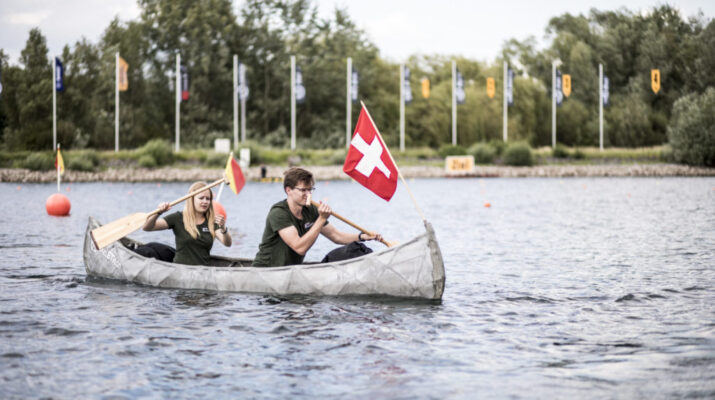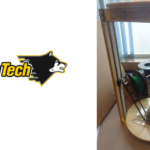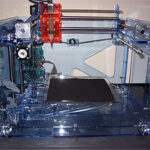

You learn something new every day, and one thing I learned recently is that concrete canoe competitions are a thing. We recently covered one of them, as it featured a winning canoe designed by students at NYU Tandon using 3D printing, but there are other canoes out there that owe their success to 3D printing. Every other year, Germany hosts the Concrete Canoe Regatta, a two-day-long race of concrete canoes, and this year marked the 16th edition. More than 1,000 participants from universities all over Europe raced 90 canoes, competing in categories such as lightest, fastest, and most attractive canoes, as well as best design innovation.
That award went, for the third year in a row, to the team from ETH Zurich. The 114-kilogram canoe, which the team dubbed SkelETHon, was a collaboration between the university’s Digital Building Technologies (DBT) and the Physical Chemistry of Building Materials (PCBM) Group. The canoe was built using a design technique called Free Formwork, developed by DBT. It involved 3D printing a thin plastic formwork, which was then used to cast the skeleton of the canoe in concrete.
“The formwork for the fibre-reinforced concrete skeleton of the boat was 3D printed in transparent PLA using FDM technology,” ETH doctoral student Andrei Jipa tells 3DPrint.com. “The transparency of the 0.8-millimetre-thick formwork allowed the casting process to be observed as it happened in order to ensure that the entire skeletal shell was fully filled.
Due to the limited printing volume of the machines used (Delta Towers and Ultimakers), the four-meter long boat was discretised into 84 separate pieces of 3D printed formwork which were chemically welded together and cast in concrete in one go.
The 3D printed formwork weighed a mere 3% of the mass of the entire boat, but 3D printing was precisely what enabled such a geometrically complex shape to be cast in concrete. The non-repetitive 3D tubular structure with varying diameters, with a precise 0.5mm texture and with non-repetitive nodes was designed through a topology optimization algorithm aiming to minimise volume and maximize stiffness. Such shapes would be otherwise impossible to manufacture with any other digital fabrication process we have access to.”

ETH Zurich researchers have been responsible for some of the most advanced 3D printing applications we’ve seen, and this design project further illustrates the excellent 3D printing and digital design resources the school offers. It won’t be a surprise if some of the students responsible for the canoe design end up being responsible in the future for more of the nanotechnology, 4D printing, and other advanced applications the school specializes in. We may even see the same technology used to design the canoe used for bigger things in the future – like buildings, for example.
“As part of a wider research into 3D printed formwork for prefabricated architectural elements at ETH Zurich, this project demonstrated how an accessible technology such as FDM can be used to produce high quality, large-scale functional structures, with the next step being to demonstrate its applicability in full size buildings,” Jipa tells us. “3D printed formwork opens up the possibility to mass customize and optimize structural elements, to reduce their weight, to include ornamentation and to integrate additional functionality into a single component.
In general, formwork represents more than 50% of the cost of concrete structures –more than cementitious materials, reinforcement and labour combined. A recyclable, lightweight 3D printed smart formwork system that integrates the assembly logic, brings a significant benefit to the fabrication process of complex architectural concrete components.”
As a matter of fact, ETH Zurich’s past winning canoes may look a bit familiar, as the technology used to develop them was then taken further into full-fledged research projects – like the Mesh Mold technique, which won the university the Swiss Technology Award in 2016, or Smart Dynamic Casting. Remember the term Free Formwork, because it’s likely you’ll be hearing about it again in the future.
The team behind this year’s winning canoe design included:
- Commercial Partners:
- Sika AG, Holcim, Allplan, RooieJoris, Specht-Technik, German RepRap
- Physical Chemistry of Building Materials (Prof. Dr. Robert Flatt):
- Nicolas Ruffray, Heinz Richner, Dr. Timothy Wangler
- Digital Building Technologies (Prof. Benjamin Dillenburger):
- Andrei Jipa, Mathias Bernhard
- Bachelor’s thesis students:
- Moritz Studer, Oliver Wach, Kathrin Ziegler
- Acknowledgements:
- Matthias Leshok, Ioannis Fousekis, Lex Reiter (PCBM), Andreas Reusser (Concrete Lab), The Concrete Canoe Club Zürich (Pirmin Scherer, Lukas Fuhrimann, Hannes Heller, Patrick Felder, Jonas Wydler, Jonas Henken, Andreas Näsbom, Anna Menasce, Caterina Rovati, Roman Wüst, Pascal Sutter, Thomas Rupper, Jonathan Hacker)
Discuss in the Concrete Canoe forum at 3DPB.com.
[Images: DBT]
When it comes to 3D real estate visualization in the USA, our service provides the perfect solution for bringing property listings to life. Through our platform, you can easily access cutting-edge 3D renderings that showcase your real estate projects in a way that attracts potential buyers and investors. Whether it's residential, commercial, or mixed-use properties, our team of experts uses advanced technology to create immersive visualizations that highlight the best features of your property, making it easier for clients to imagine the space as their own.
Through our website, you can quickly get high-quality 3D real estate visualizations that are tailored to your specific needs. With our help, you'll stand out in the competitive real estate market by offering potential buyers a realistic, interactive view of your property. Our efficient process ensures a fast turnaround time, while our attention to detail guarantees that every aspect of the property is represented accurately, giving you a powerful marketing tool to promote your real estate listings.






